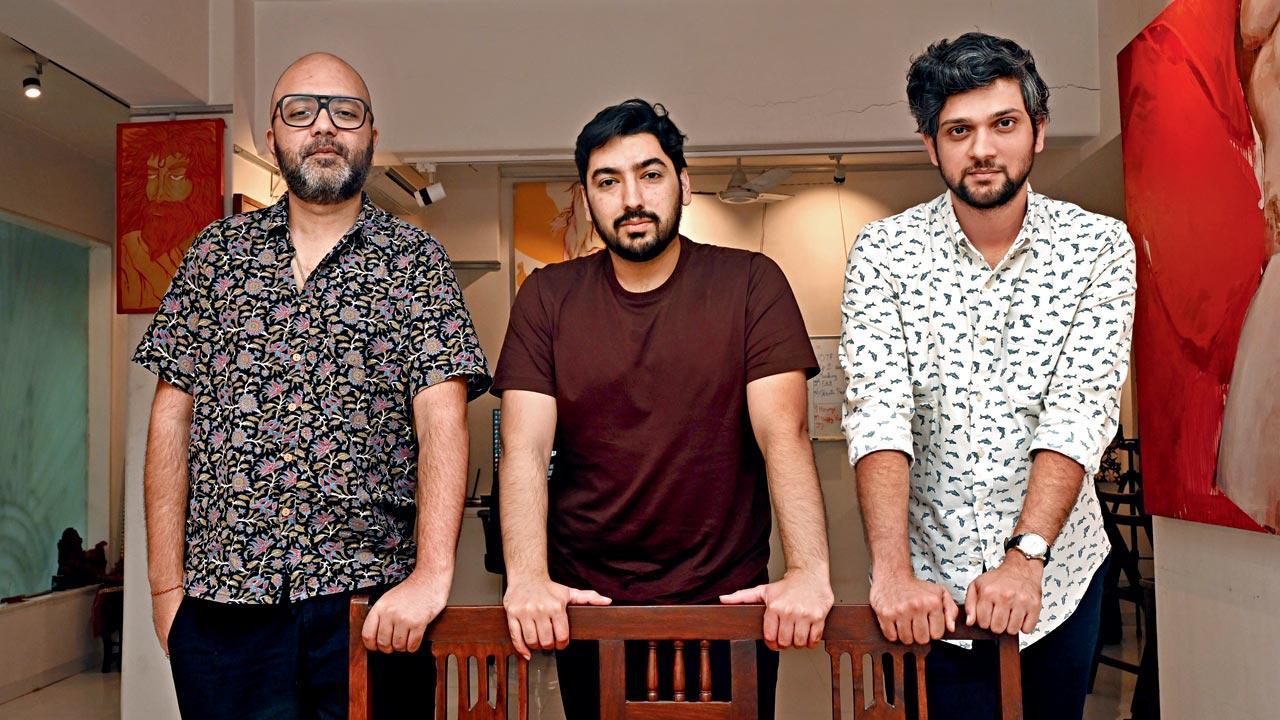From executing sequences for mythological dramas to making 100-foot murals, Hridaye, Nishant, and Vishal on how their studio is the hub for all things AI in Bollywood

Nishant Tahilramani and Hridaye Nagpal, along with Vishal Balsara (in maroon), believe in making their studio ‘future-proof’. Pic/Atul Kamble
If you ask industry insiders to recommend a studio for AI-related services in filmmaking, chances are they will name Gobo Studios. Run by filmmaker Hridaye A Nagpal, who co-directed Amazon Prime Video’s Rainbow Rishta, along with Nishant Tahilramani and Vishal Balsara, Gobo Studios is a creative studio for all practical purposes. Nagpal corrects us, “We are the future-proof creative studio.”
ADVERTISEMENT
In March 2022, Tahilramani told Nagpal about the Dall-E2 opening up to the common people. Dall-E is the art vertical of Open AI that also has patented Chat GPT. Little did they know that this development would, one day, help them set up their studio. Nagpal recalls, “I couldn’t bring myself to believe that text prompts can generate images. But I started playing with it. We had some written concepts and scripts, [which were kept] over time because it wasn’t even possible to visualise them, and needed money. But AI gave me the opportunity to bring these ideas to life. A lot of them were queer history ideas or futuristic ideas [rooted in] Indian setting. One of them was called Vedic Future. When I made it, it started getting traction online. My living room was the starting point of this studio.”
Do more
Within weeks of toying around with Dall-E2, Midjourney, Sora and Stable Diffusion, the trio understood that AI could be utilised for more than just dance videos. “It felt like AI was not being utilised to the potential it should be. The tools have powers, and coupled with imagination, it can make wonders.” That is when they decided to apply AI into their daily business, and thus was set up Bogo Studios in late 2022. Nagpal shares, “We thought about how to use AI to help reduce time between ideas and execution. When we tested our theory, we saw we could achieve spectacular output with a smaller team and much lesser budget. Once we got to this point, we realised it could be applied to everything—from short films to murals and artworks. So, we started taking on clients. We have explored various tools, including an AI Mocap tool called TNT.”
One of their biggest projects is an upcoming big-budget crime drama slated to come out early next year. Nagpal reveals that the team, who operate out of their Juhu office, faced the challenge of visualising the protagonist’s complex thought processes. “We created a dreamlike aesthetic that seamlessly blended reality with the character’s inner world, after training our own AI models to create flowing visuals.”
Another upcoming project for a streamer involved crafting intricate flashbacks. Nagpal says, “For this, we used Stable Diffusion to generate lifelike scenes that matched the visual identity of the rest of the show. Using traditional methods, this would have been a time-consuming process. Our AI-led approach opened up new possibilities for storytelling, giving us the opportunity to focus more on the aesthetics and treatment of the scenes without being burdened by the extensive effort required for live-action or CGI production. It allowed us to streamline the process, giving us more creative freedom and efficiency.”
From Bollywood to brands
He says the movie industry is embracing AI. “In fact, companies from all facets are coming to us, including fashion brands and a sports equipment company. We designed 100-foot digital murals that will be unveiled at the Bengaluru airport by September. Speaking strictly of the movie business, creators have been open to adapting to AI. Even in its basic stage, there was a Boat Rockerz ad that was made way before we existed as a company. We’ve got enquiries from every department, even from a regional channel for a mythological show. Our backgrounds in filmmaking helped. I am a filmmaker, while Nishant is a producer and has worked on several comedy specials of Vir Das. Vishal has made many ads.”
We ask them about Lego Bollywood Story, a 10-minute showreel that they made using Unreal Engine and well, Lego blocks. Tahilramani shares that the studio wants to create more stories that are rooted in Indian mythology. “As children, when you watched all cool, fantastical, sci-fi ideas, you wished for them to have an Indian setting. You had Amar Chitra Katha, but we didn’t get to enjoy the animation or execution.”
Quality is a question
A large point of discussion with AI-generated creations is inferior quality. But Balsara doesn’t believe in generalising it thus. “I don’t see humans being replaced by AI. That’s the starting point of such a conversation. The quality will be perfected over the years. But AI is also democratising filmmaking, and that’s an aspect that cannot be ignored. You are not replacing people; in fact, you’re giving more agency to people.” He makes his case by citing an example. “Say, you had an idea that required a shot of Godzilla running through Mumbai. If you were a smaller company or filmmaker, you couldn’t have done that. You’d need bigger companies to give their money. AI is giving you the power to execute bigger ideas. Right now, if we have X successful production studios in the country, that number will quadruple with AI.”
 Subscribe today by clicking the link and stay updated with the latest news!" Click here!
Subscribe today by clicking the link and stay updated with the latest news!" Click here!












